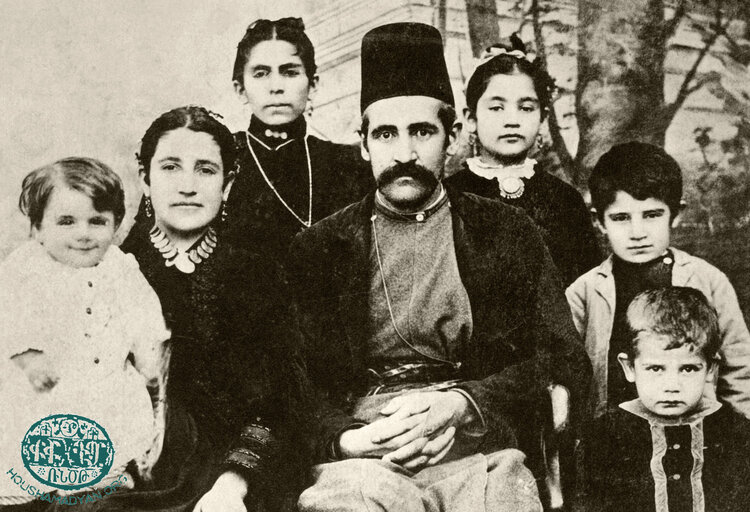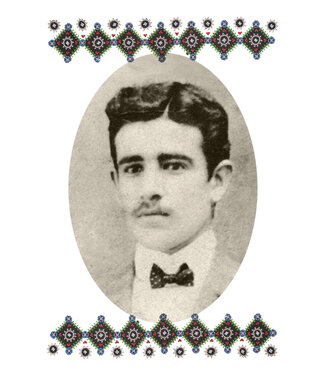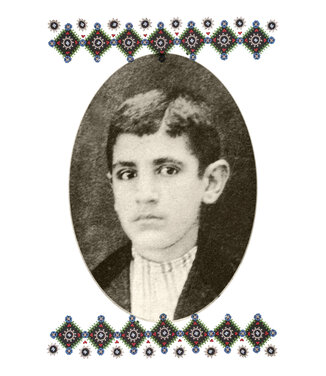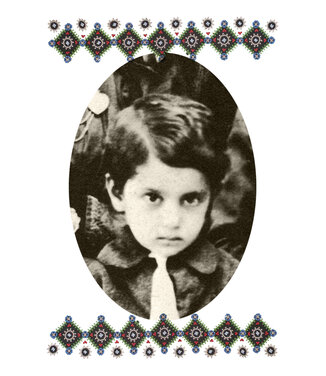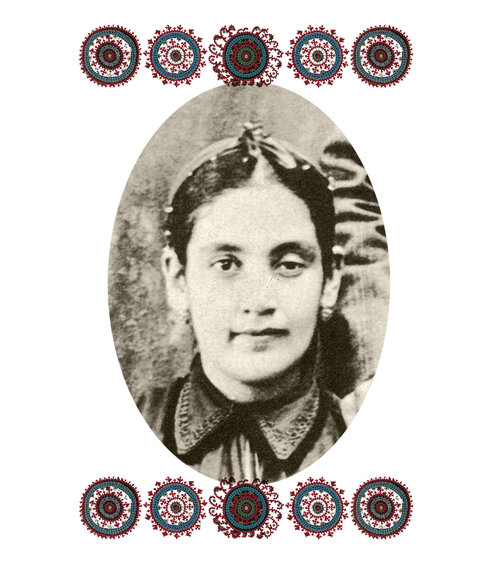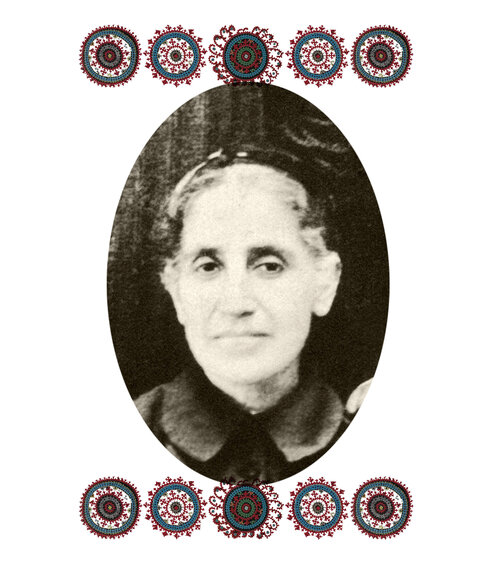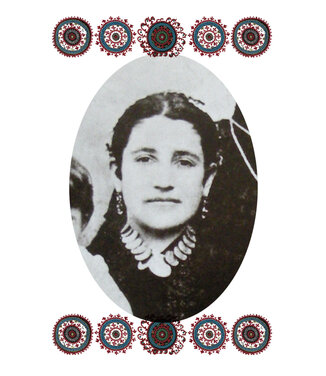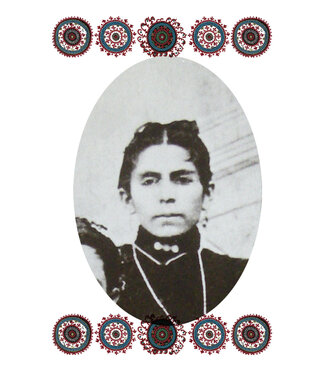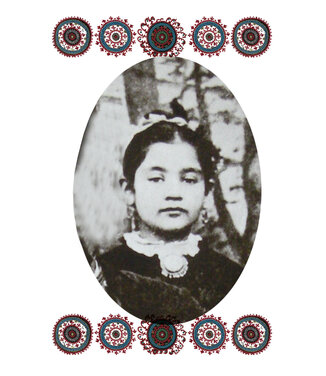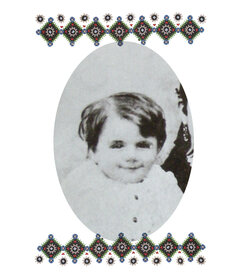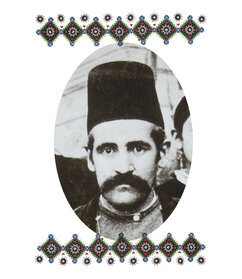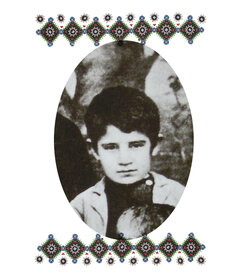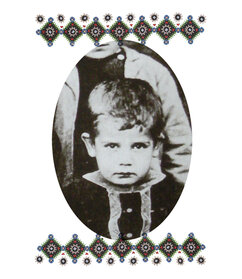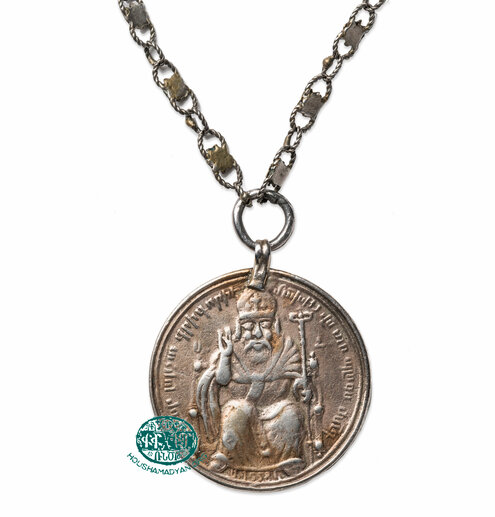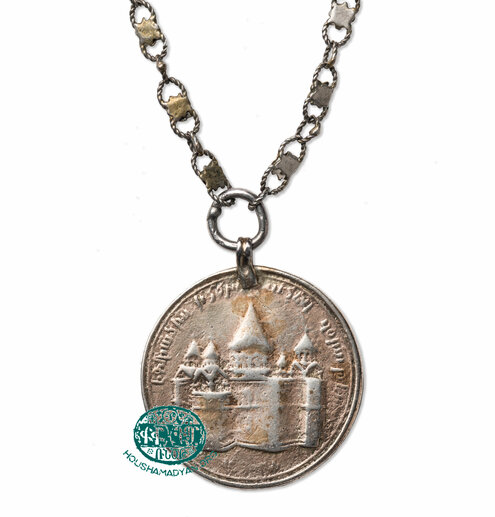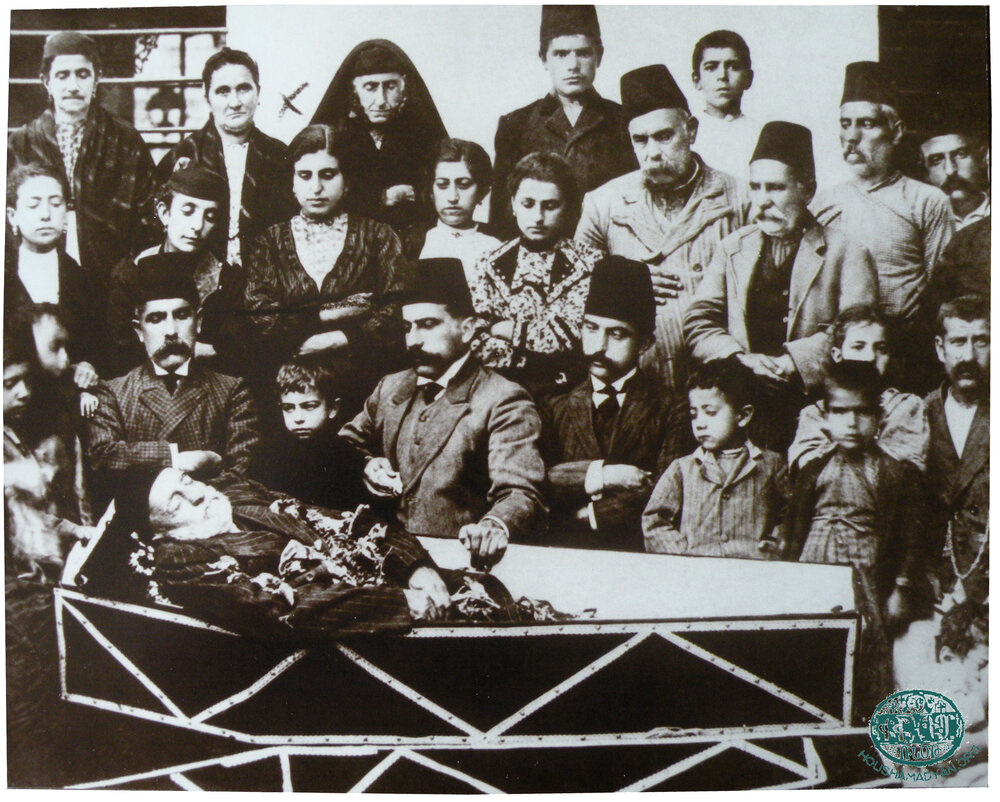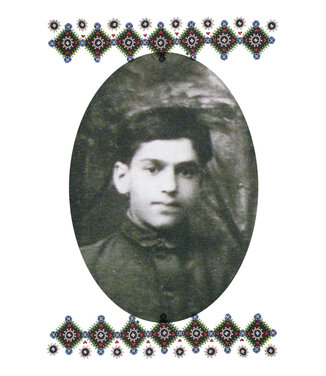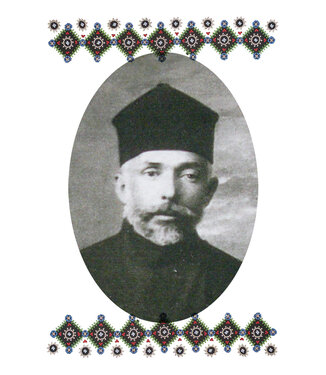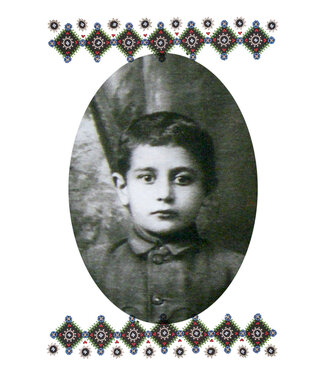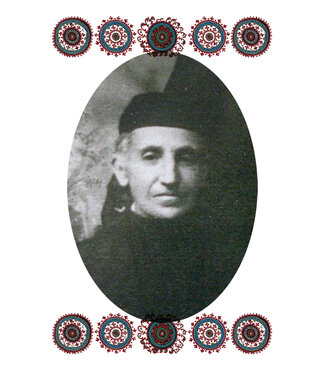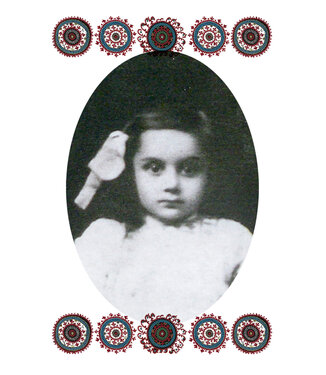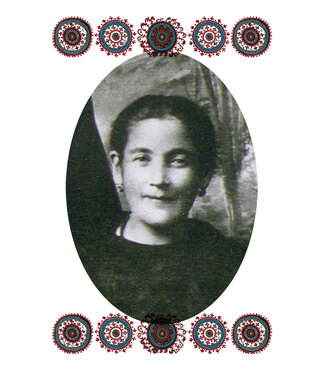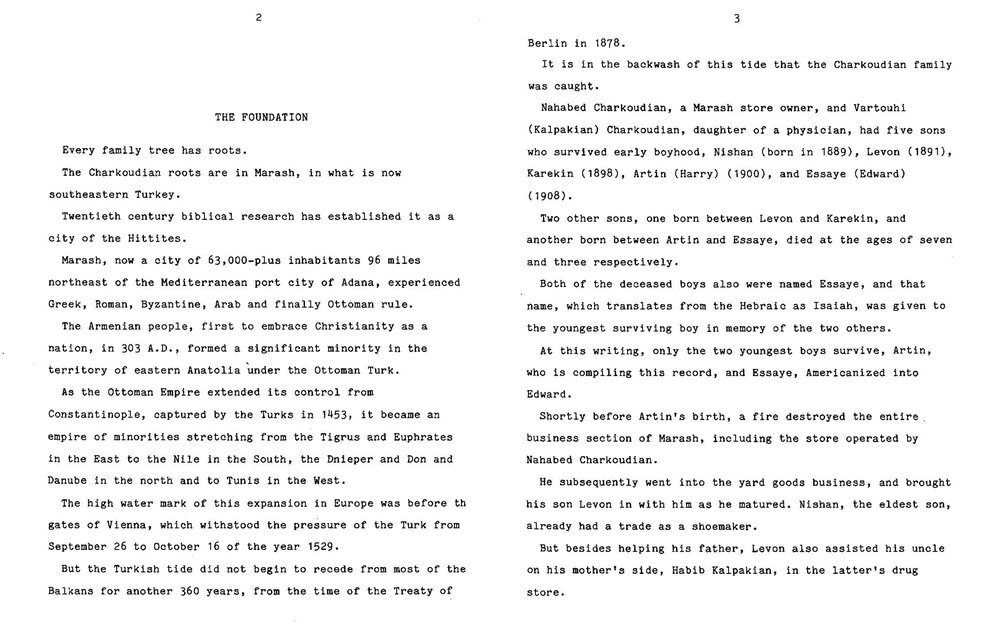Karen Bedrosian Richardson collection - New York

The family information and photographs, which tell the story of the family of Reverend Sahag Der Bedrosian and his wife, Zabel (née Chorbajian), her ancestors (the Kalpakian family of Ayntab/Marash), and the couple’s 4 children, come from the individuals themselves, their records, writings and various articles written about them as well as from the invaluable memoir of Harry Charkoudian detailing the genealogy and travails of the Kalpakian family going back to the 1800s. This memoir can be accessed in pdf format in this page.
Reverend Sahag Der Bedrosian (3/26/1877 – 10/08/1927), a descendant of 20 generations of Armenian Apostolic priests, was the first Vicar of the Saint Stepanos Church in Marash, as well as locum tenens for the Prelate from 1908-1914. His wife Zabel (10/15/1885 – 10/22/1933) was born in Marash – the daughter of Lucia (née Kalpakian) Chorbajian and Nishan Chorbajian. When she was 10 years old, her father, who was the Secretary General of the local branch of the Hunchakian Party, was killed during the 1895 massacre of the Armenians, and her mother Lucia, who was 30 years old at the time, was briefly imprisoned. After Lucia’s release, Zabel and her younger brother Arsen were sent to live in an American orphanage in Marash while attending the Marash Academy, and Lucia and her youngest son Yeznig went to live with Lucia’s mother and brother. Family lore has it that Zabel and the future Rev. Sahag Der Bedrosian met while she was a student at Marash Academy and he was a student at the American Theological Seminary in Marash, after graduating from St. Paul’s College in Tarsus. She graduated from Marash Academy, became a teacher and they married in 1903, when she was 18.
In 1915, Rev. Sahag was arrested along with other community leaders and deported to Der Zor. From Der Zor, Der Sahag was summoned to Aleppo, where he was arrested and jailed on 15 occasions before being subjected to a military tribunal on the accusation of subversive activities based on a letter he sent to the AGBU headquarters in Cairo asking for financial aid for the Armenian villagers around Marash. He was exiled to Der Zor again but managed to escape and was sheltered by a cousin in Aleppo for the duration of World War I.

Der Sahag returned to Marash in 1918 and organized the first Armenian National Union to take care of the 25,000 returning deportees. He wrote a letter to Catholicos Sahag II of Cilicia describing the deteriorating and desperate conditions in Marash in 1919, a draft of which was found among his papers, and is accessible at http://archive.org/details/DerBedrosian1919Marash. With the withdrawal of the French troops from Marash in 1920, and the failure of the Turkish mandated peace commission to Ayntab, of which Der Sahag was a member, the persecution and living conditions in Marash once again became intolerable.
In 1922, when the Turkish government allowed the surviving Armenians to emigrate, Der Sahag left for Aleppo with the survivors of his family – his wife and 3 of his children. On September 14, 1922 the Der Bedrosian family traveled to Marseilles, France, and boarded the Britannia ship for the United States. They landed in Rhode Island on October 1, 1922.
According to their immigration documents, Der Sahag was 45 years old when he came to the United States. His wife, Zabel, was 37. Their son Askanaz (Alvin) was 10, his sister Sahaganoush (Mary) was 7 and the baby Smpad (Samuel) was 1 ½ years old. Their oldest son, Nshan (Mark), had immigrated in July 1922 with his grandmother Lucia directly to Springfield, MA where Lucia's youngest son, Yeznig and other Kalpakian/Charkoudian relatives had already settled.
Der Sahag and his family went directly to Troy, New York where Der Sahag began his job as pastor of the St. Peter Armenian Apostolic Church, which was then located in Green Island, New York. He was the 4th priest to serve as pastor of this church, which expanded and moved first to Troy, New York and then to its current location in Watervliet, New York.
Five years later, Der Sahag died at the age of 50. His widow Zabel and her 4 children moved from Troy, New York to Springfield, Massachusetts where they lived with relatives until 1932, and where Mark and Alvin were able to find intermittent employment at the American Bosch Corporation plant. During the Depression the plant closed and the brothers managed to support their family by operating their own radio repair shop.
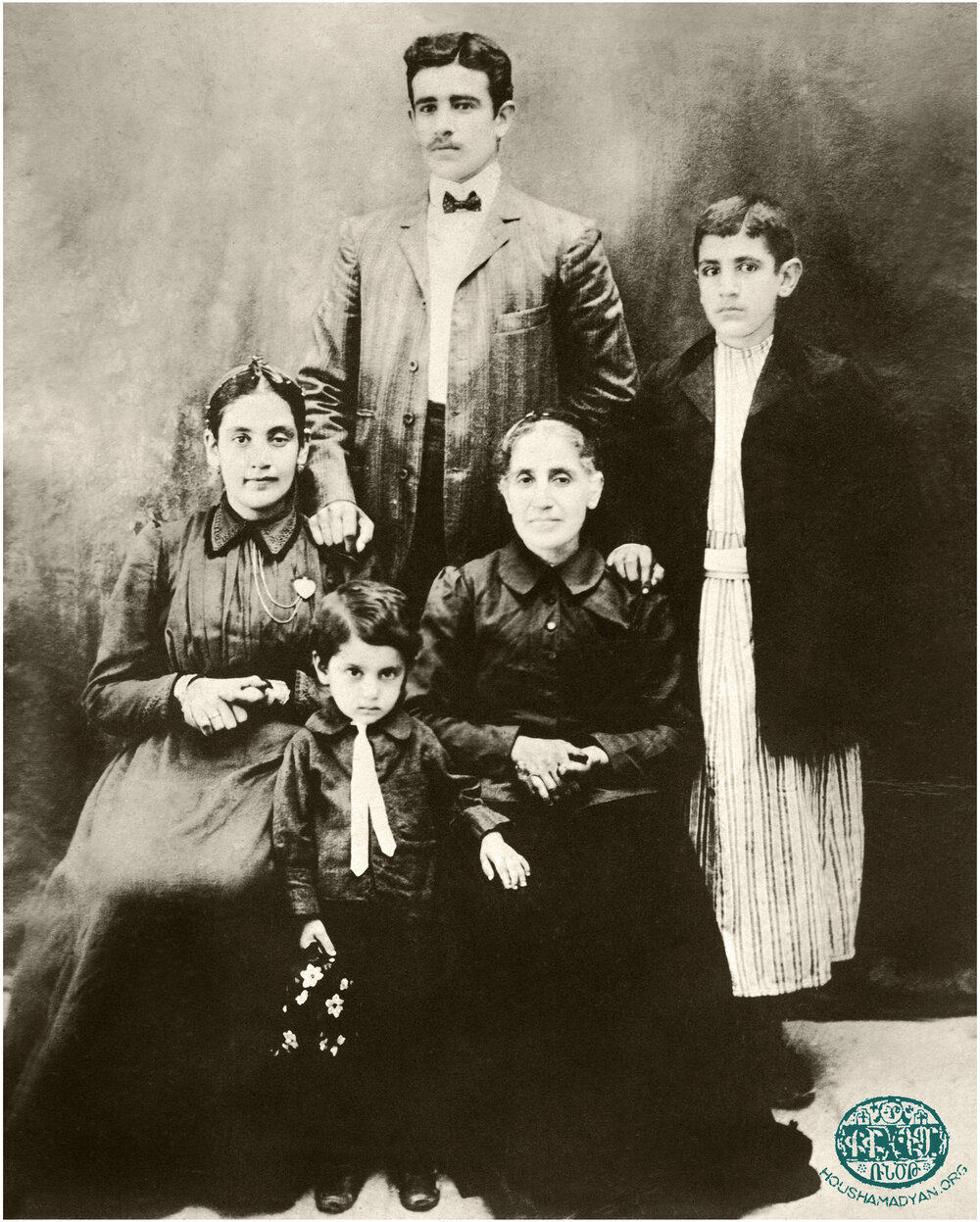
Sitting from left to right are Zabel Der Bedrosian (née Chorbajian), in front of her is her first child Nshan (Mark) Der Bedrosian, and sitting on the right is Lucia Chorbajian. Standing in the back row are Lucia's sons Arsen Chorbajian on the left and Yeznig Chorbajian on the right.
| Arsen Chorbajian was born in Marash in 1887, he died in New Jersey in 1976. Arsen was a very good student; after graduating from the Marash Academy, he earned a scholarship to attend the Tarsus college, after which he went to the United States in 1908 to attend Yale University when he was 21 years old. Arsen got a PhD and had a long and successful career in electronics and physics. Arsen Der Bedrosian changed his surname to Lucian.
| Yeznig Chorbajian,who is Arsen's younger brother, was also born in Marash.
| Nshan (Mark) Der Bedrosian, who appears to be 2 or 3 years old in the photo, he was born on June 29, 1905, thus we can assume that the photo was taken in 1907 or 1908 in Marash. Nshan Der Bedrosian would immigrate to the States with his grandmother Lucia in 1922. He died in New Jersey in 1987.
| Zabel Chorbajian was born in Marash in 1885. She graduated from the Marash Academy and became a teacher. While still a student at the academy, she met a young seminarian named Sahag Der Bedrosian, who she would later marry in 1903, when she was 18 years old.
| Lucia Chorbajian (née Kalpakian) is Zabel's mother, she was born in 1865 in Ayntab. She was married to Nshan Chorbajian.

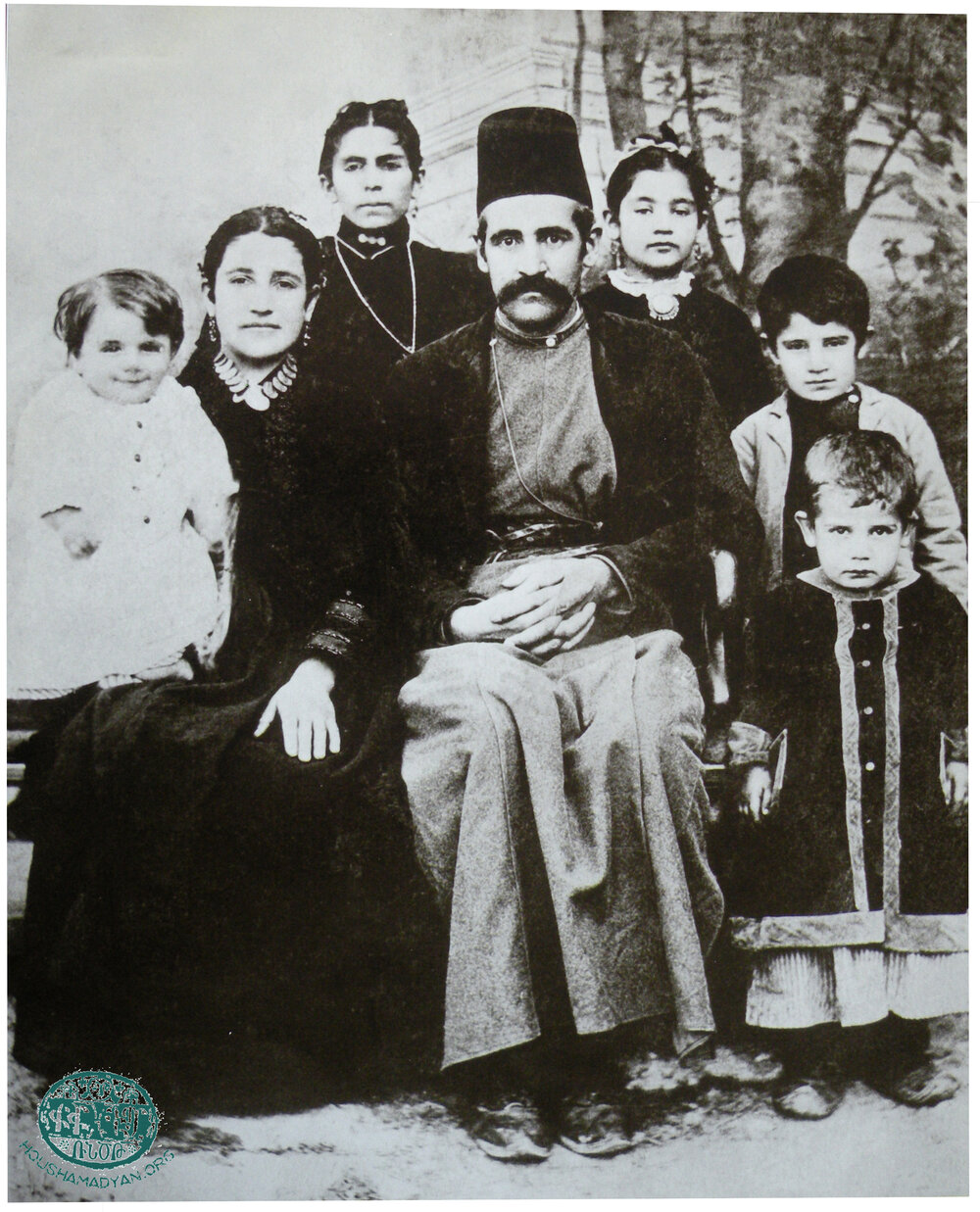
Sitting from left to right are: the baby Yeznig Chorbajian, his mother Lucia Chorbajian (née Kalpakian), Nshan Chorbajian. The two girls standing from left to right in the back row are: Nshan Chorbajian's sister (name unknown) and Zabel Chorbajian (Lucia and Nshan's daughter). Standing just below Zabel is her brother Arsen, while the little boy standing in the front row to the right is their youngest brother Hrant Chorbajian.
| Lucia Kalpakian Chorbajian was born in Ayntab in 1865 and went to the US when she was 57 years old - she died in Pennsylvania in 1949. Lucia was the sister of Dr. Aboujan Kalpakian, who was a prominent physician in Marash, a descendant of a long line of physicians (going back to the 1730’s).
| Miss Chorbajian is Nshan's sister (name unknown). Nshan and his sister were adopted into the Chorbajian family, we believe their surname at birth was Pamboukian. She is said to have married one of the four Armenian princes of Zeitoun.
| Zabel Chorbajian is the daughter and oldest child of Lucia and Nshan; she was born in Marash on October 15, 1885. Zabel went to the United States in 1922 at the age of 37, she died in 1935, at the age of 50.
| Yeznig Chorbajian was the youngest child of Lucia and Nshan. After the death of his father Nshan, Yeznig and his mother Lucia went to live with Lucia’s mother and brother, while his siblings ended up in the orphanage. Later, Yeznig was engaged in the trade of jeweled embroidery from Marash, but left Marash years ahead of the rest of the family; he first went to Cairo to live with an uncle, and then went to the US in 1914. In America, Yeznig worked as a shoemaker.
| Nshan Chorbajian was born in Marash in 1857, the youngest son of Tavit Chorbajian and was a kazaz (a silk thread maker) by trade, following in the footsteps of his father. He was instrumental in forming the first theatre group in Marash that produced plays for Armenian and Turkish audiences. He was the secretary general of the local branch of the Social Democrat Hunchag Party before being killed during the 1895 massacres. After killing Nshan, the soldiers went to Lucia's house to interrogate her and hoped to get ahold of the Hunchag Party's records. Unable to find anything, they imprisoned Lucia briefly. She was 30 years old at the time.
| Arsen Chorbajian is the oldest son of Lucia and Nshan, he was born in Marash in 1887. Arsen went to the United States in 1908 and changed his last name to Lucian. Zabel was 10 and Arsen was 8 years old when their father Nshan was killed. Zabel and Arsen lived in the American orphanage in Marash while they attended the Marash academy.
| Hrant Chorbajian was the middle Chorbajian brother, he died in childhood.
Medallion from 1558 that belonged to the Der Bedrosian family.
Karen Bedrosian Richardson inherited this medallion dated 1558, it was passed down through her father's family, where her grandfather, Reverend Sahag Der Bedrosian, was the 21st generation (and last) in a line of Armenian Apostolic priests.
The writing in Armenian on the front side of the medallion helps us decipher that the engraving depicts Sourp Kirkor Lousavoritch (St Gregory the Illuminator), while Etchmiadzin is depicted on the back side.

The Kalpakians, originally from Marash, are Karen Bedrosian Richardson's paternal grandmother's, Zabel Chorbajian, ancestors; Zabel's mother was Lucia Kalpakian.
In this photograph, members of the Kalpakian family are gathered around the deceased, Aboujan Kalpakian, for a post-mortem family photograph; those present are mainly Aboujan Kalpakian's children: Haiganoush, Avedis, Janig, and Habib, and their families.
The identities of the people standing in the back row from left to right are unknown, the boy standing last in the back row, wearing white could be Avedis's son.
Standing in the second row from left to right are: Mari Varjabedian Kalpakian (Avedis's wife), Haiganoush Kalpakian Keroghlian (the daughter of the deceased), Mari Mesrobian Kalpakian (Jani'g wife), identity unknown, Ovsanna Dischekenian Kalpakian (Habib's wife, children: Lucy and Jack), identity unknown, identity unknown.
Standing in the first row from left to right are: possibly Avedis's son, possibly Avedis's other son, Avedis Kalpakian (oldest son of the deceased, children: Anna, Zarouhi, Nshan, Hagop, Onnig), Karnig Kalpakian (Janig's son), Janig Kalpakian (the second son of the deceased, children: Karnig and Jack), Habib Kalpakian (youngest son of the deceased, children: Lucy, Jack, Eddy, Mary), Onnig Kalpakian (Avedis's son), Essaye Charkhoudian, and Nahabed Charkhoudian.

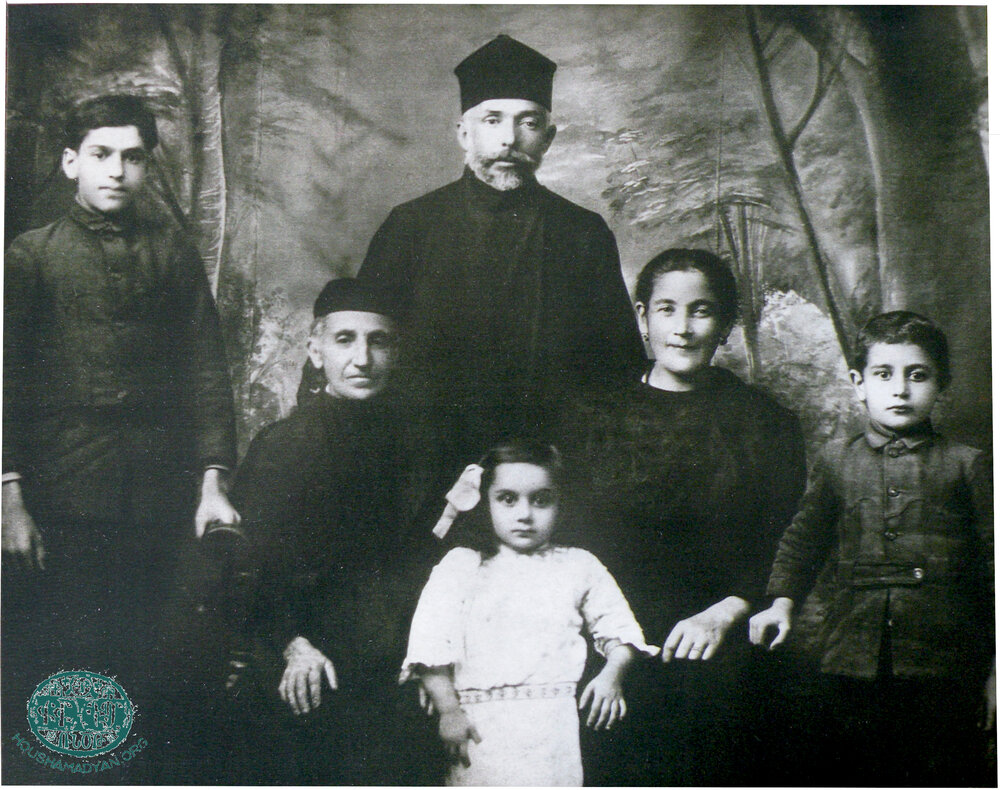
Standing from left to right are: Nshan (Mark) Der Bedrosian, Reverend Sahag Der Bedrosian. Sitting from left to right are: Lucia Kalpakian Chorbajian and the reverend’s wife Zabel Chorbajian Der Bedrosian. The two children standing from left to right are: Sahaganoush (Mary) Der Bedrosian and Askanaz (Alvin) Der Bedrosian.
The Der Bedrosians are Karen Bedrosian Richardson's paternal ancestors, while Father Sahag Der Bedrosian is Karen's paternal grandfather.
Father Sahag Der Bedrosian
Father Sahag Der Bedrosian was born in 1877 in Marash. He received his elementary education in the local central school. Later, he attended the American St. Paul College in Tarsus and the American Theological Seminary in Marash. After graduation, he worked as a teacher for four years in his birthplace. Father Sahag got married in 1903, and had four children; he was ordained as a priest in 1906 by Catholicos Sahag II in Sis. He became the pastor of the St. Stephen Armenian Apostolic Church in Marash.
In 1915, along with other community leaders, Der Sahag was arrested and deported to Der Zor, where he was jailed on 15 occasions before being transferred to Aleppo to face the military tribunal, on account of a letter he had written to Boghos Nubar Pasha.
After the Armistice, he returned to Marash and organized the first Armenian National Union to take care of the 25,000 returning deportees. In 1922, he and his family left Marash indefinitely and established in Aleppo. After a sojourn here of five months, he was invited to the pastorate of the St. Peter Armenian Church, then located in Green Island, New York, thus the family immigrated to the United States; Father Sahag served at the St. Peter Armenian Church until his death in 1927.

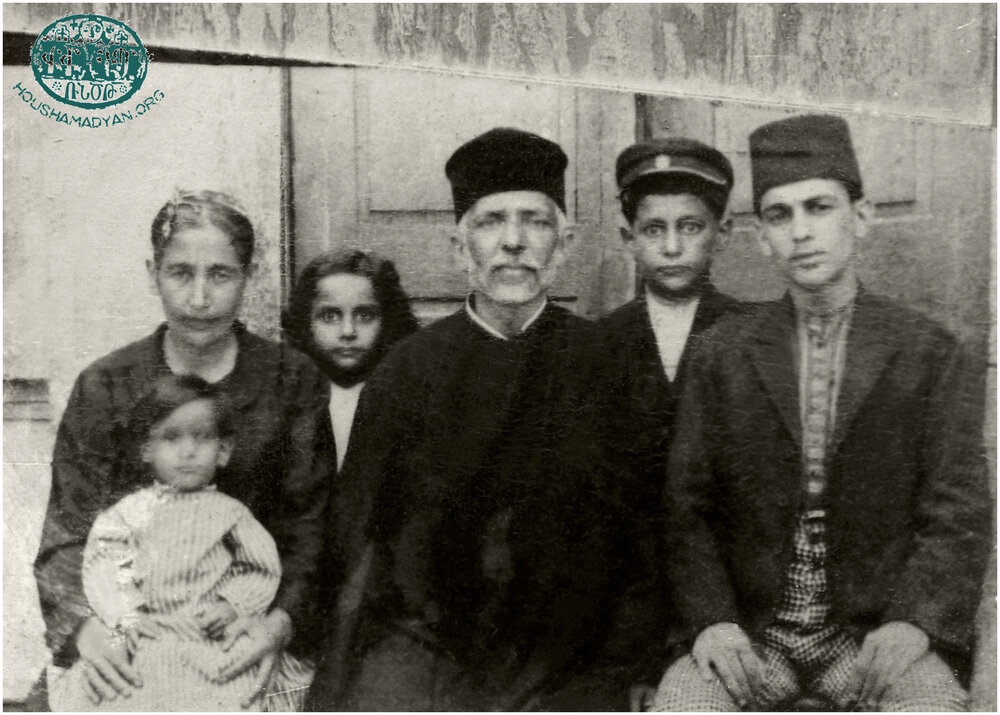
Sitting from left to right are: Zabel Der Bedrossian with Smpad (Samuel) Der Bedrosian on her lap, Father Sahag Der Bedrosian, and Nshan (Mark) Der Bedrosian. The two children standing from left to right are: Sahaganoush (Mary) Der Bedrosian and Askanaz (Alvin) Der Bedrosian.
This photo was taken around 1922 just after the family had arrived to the United States or just before leaving.
According to the Der Bedrosian immigration documents, Reverend Sahag Der Bedrosian was 45 years old when he went to the US, while his wife Zabel was 37 years old. Askanaz Der Bedrosian was 10 years old, his sister Sahaganoush was 7 and Smpad was 1 and a half years old.
In the United States, Father Sahag became the pastor of the St. Peter Armenian Church in Green Island, New York, he was much loved by his congregation, but died 5 years after his arrival to the States. The cumulative effects of the torture he suffered while imprisoned in Turkey left him in very poor health. After his death, Zabel and the children moved to Springfield to be closer to their relatives.

From Marash to Massachusetts
The memoir “From Marash to Massachusetts” is from Harry (Artin) Charkhoudian's collection and was written in 1981 by Thomas A. Crawford Jr. Here, the author presents the history of the Kalpakian and Charkhoudian families from their native Marash to the United States.
Nahabed Charkhoudian was a shopkeeper in Marash, he was married to Vartouhi Kalpakian, whose family were pharmacists. The couple had 5 sons: Nshan (1889), Levon (1891), Karekin (1898), Artin (Harry) (1900) and Essaye (Edward) (1908).
In 1912, when Levon reached the age when he had to do his military service, the family sent him to the States, where he settled in Springfield MA. At the time, the Balkan war was on and soldiers from the Ottoman army were sent to the front, thus in 1913, in order to avoid military service, Nshan also left for the States and joined his brother. Nshan was a shoe maker in Marash, so he continued the same profession in the States.
In the beginning, Levon worked as a server in a hotel, later he studied at the university in Boston to become a pharmacist. While still in Marash, Levon had spent years working in the pharmacy of his uncle Habib. It was Nshan sponsored his brother’s education. In 1917, Levon graduated and having received a scholarship, he continued his education in the field of chemistry.
In 1914, Nahabed Charkhoudian died of a heart attack. Vartouhi and her three sons (Karekin, Artin and Essaye) moved to live in the house of brothers Dr. Avedis and Habib. In 1915, the Kalpakian brothers were not exiled and survived the Genocide because they were pharmacists. Vartouhi and her sons also survived and continued to live in Marash.
After the war, Marash was occupied by the French army and Armenian life continued under French rule. However by the beginning of 1920, after the revolt of the Turkish nationalists, the French army withdrew from Marash, and as a result, a few thousand Armenians also left Marash. Artin and Karekin Charkhoudians were among the Armenians who left Marash, and reached Adana. Their brothers, who were in the States, transferred money so Artin and Karekin would join them. Thus in 1920, Artin and Karekin took a boat from Mersin, went to Izmir, then Istanbul, from there they went to France and finally reached New York.
In December 1921, Essaye Charkhoudian and his mother Vartouhi, who were still in Marash, went to Aleppo, then Lebanon, and in 1922 they reached the States and joined the rest of the family who were already residing there.
To read the full memoir in pdf version please click on the photo below.

